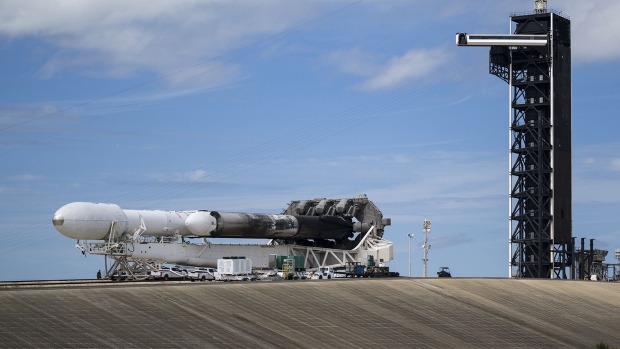Oct 13, 2023
NASA Probe Bound for Metal Asteroid to Launch on SpaceX’s Falcon Heavy
, Bloomberg News

(Bloomberg) -- NASA’s massive Psyche spacecraft launched Friday atop SpaceX’s Falcon Heavy rocket on an unprecedented journey to probe a metal-rich asteroid for insight into Earth’s own rocky core.
SpaceX’s Falcon Heavy, one of the world’s most powerful operational rockets, lifted off from Florida’s Kennedy Space Center at 10:19 a.m. local time. Its launch marked the first time NASA has used the Falcon Heavy to launch a major interplanetary science mission. The Falcon Heavy’s side boosters successfully landed on SpaceX’s ground landing pads after launch.
The Psyche payload separated from the rocket a little over an hour after launch. That put the robotic Psyche spacecraft on course to meet up with its asteroid target in nearly six years. Once there, the spacecraft will orbit the metal-rich space rock for more than two years, using instruments to analyze the object’s composition.
The goal of the $985 million mission is to find out more about how the rocky planets in our Solar System came to be. Scientists believe that metal asteroids like Psyche may hold the same ingredients and materials that helped to form the cores of the inner rocky worlds, including our own.
“We have a lot of questions about our Earth’s metal core, and we can’t ever go visit it,” said Lindy Elkins-Tanton, who as the mission’s principal investigator oversees the spacecraft and its science. “We can’t visit any of the other metal cores, even the moon’s metal core is too dense, too hot. So here’s this one chance.”
The potato-shaped Psyche, between 144 and 173 miles (232 and 278 kilometers) wide, might be part of an early building block of Earth’s solar system, known as a planetesimal. Back when our cosmic neighborhood was blinking into existence, dust and gas came together to form these continent-sized objects of rock and iron zooming around the sun. These planetesimals, which had their own iron cores like Earth, merged together over time to form the rocky planets.
Long Road
Originally, the spacecraft was supposed to fly roughly a year ago. But late delivery of the spacecraft’s flight software and testing equipment meant NASA ran out of time to complete required testing before its launch window closed.
An independent board formed by NASA to review the delays also determined the agency’s Jet Propulsion Laboratory was understaffed and recommended establishing “open communications” between teams.
“Major communication failures on Psyche resulted in project management not recognizing the seriousness of issues until too late to resolve them in time for a 2022 launch,” the review board found.
Psyche’s delay also pushed a separate mission to Venus called VERITAS by at least three years, as NASA diverted resources to get Psyche off the ground on time.
On Sept. 28, NASA pushed back the Psyche launch by a week after engineers discovered an issue with the thrusters used to maneuver the spacecraft in space. They found that the devices might get too hot in their original configuration, so now NASA plans to operate them at cooler temperatures.
If all goes well with Friday’s launch, the spacecraft should arrive at the Psyche asteroid in July 2029.
Scientists are fairly certain Psyche is a metal-rich asteroid based on measurements of its density taken by radar and telescopes. But collecting images of the asteroid to learn what it looks like is a top priority.
“We don’t have any idea what the surface is like,” Elkins-Tanton said. “We’ve never seen a metal surface before.”
(Updates third paragraph to show that the Psyche payload separated from the rocket)
©2023 Bloomberg L.P.





